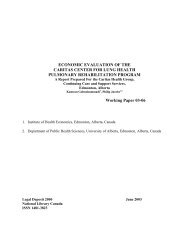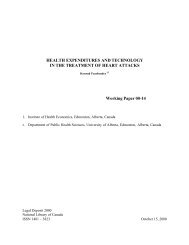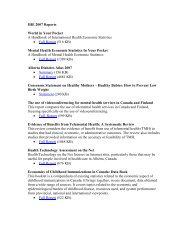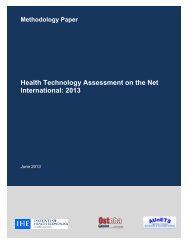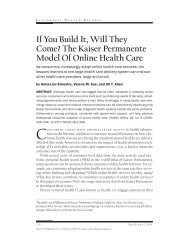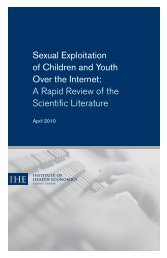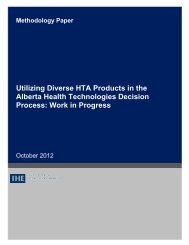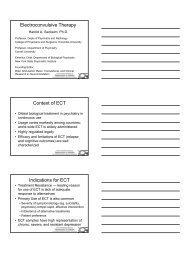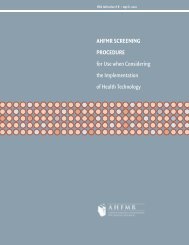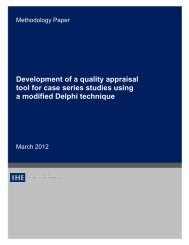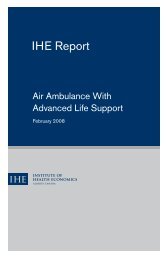IHE Report - Institute of Health Economics
IHE Report - Institute of Health Economics
IHE Report - Institute of Health Economics
- No tags were found...
Create successful ePaper yourself
Turn your PDF publications into a flip-book with our unique Google optimized e-Paper software.
Barriers related to the properties <strong>of</strong> the HRQL measures: Poor reliabilityand ceiling effects were identified as barriers to the use <strong>of</strong> HRQL measuresin clinical care by McHorney et al (2002).SUMMARYIn summary, HRQL instruments should be easy to administer, score andinterpret. These instruments should be able to cover a range <strong>of</strong> age, severity,diagnoses, co-morbidities and assess a full range <strong>of</strong> health among diversepatient groups at a single point in time and overtime. HRQL measures shouldexhibit minimal floor and ceiling effects and should be highly reproducibleovertime and have a small standard error <strong>of</strong> measurement for use inlongitudinal monitoring. They should also yield highly accurate and precisescores that have a small standard error <strong>of</strong> measurement for use in clinicaldecision making. HRQL should be valid indicators <strong>of</strong> the constructs they arehypothesized to represent, be responsive to clinical change and have evidence<strong>of</strong> validity for individual patient applications when used for that purpose(McHorney and Tarlov, 1995).The choice <strong>of</strong> clinical area in which to assess the routine use <strong>of</strong> a HRQLinstrument should be made on the basis <strong>of</strong> type <strong>of</strong> patients, characteristics <strong>of</strong>the disease and its management. Previous studies described the usefulness <strong>of</strong>HRQL measures when applied to chronically ill populations (palliative care,oncology, AIDS) in specialist centres (Morris et al. 1998). In this scenario,the use <strong>of</strong> HRQL instruments is recommended to record the patient’sperceptions about his/her condition. The inclusion <strong>of</strong> these measures inroutine clinical care has the potential to add valuable information to thepatient’s medical history. HRQL measures provide a comprehensive picture<strong>of</strong> the patient’s condition. Information on the patient’s emotional status(anxiety and depression) complements physiological and pathologicalinformation and has the potential to improve patient clinical care.HRQL STUDIES CONDUCTED AT THEINSTITUTE OF HEALTH ECONOMICSInvestigators at the <strong>Institute</strong> <strong>of</strong> <strong>Health</strong> <strong>Economics</strong> (<strong>IHE</strong>) have been active indeveloping, applying, and evaluating measures <strong>of</strong> HRQL. Several studies havebeen conducted at the <strong>IHE</strong> examining the importance <strong>of</strong> HRQL measures inpatient’s care, economic evaluations and decision making.The following <strong>IHE</strong> Working papers from 1997 to 2006 were reviewed:Johnson et al. (1997) conducted a study to derive a set <strong>of</strong> US-basedpopulation weights for the standard set <strong>of</strong> health states described inthe EQ-5D health questionnaire. The results showed that the valuations11The Importance <strong>of</strong> Measuring <strong>Health</strong>-related Quality <strong>of</strong> Life



